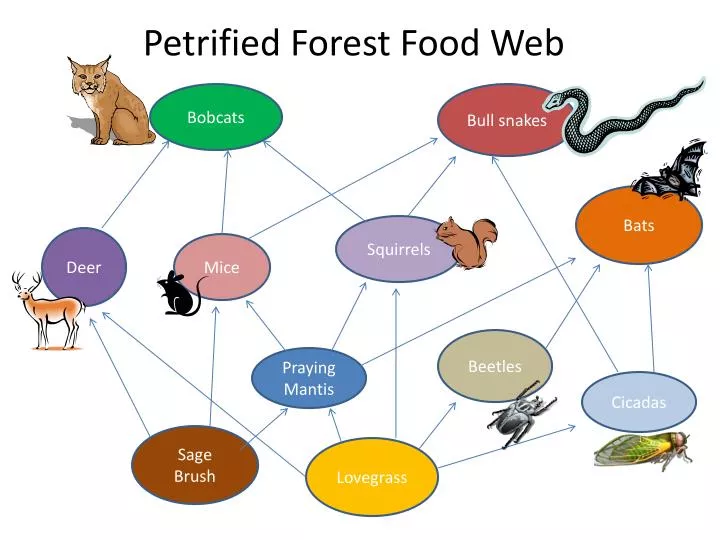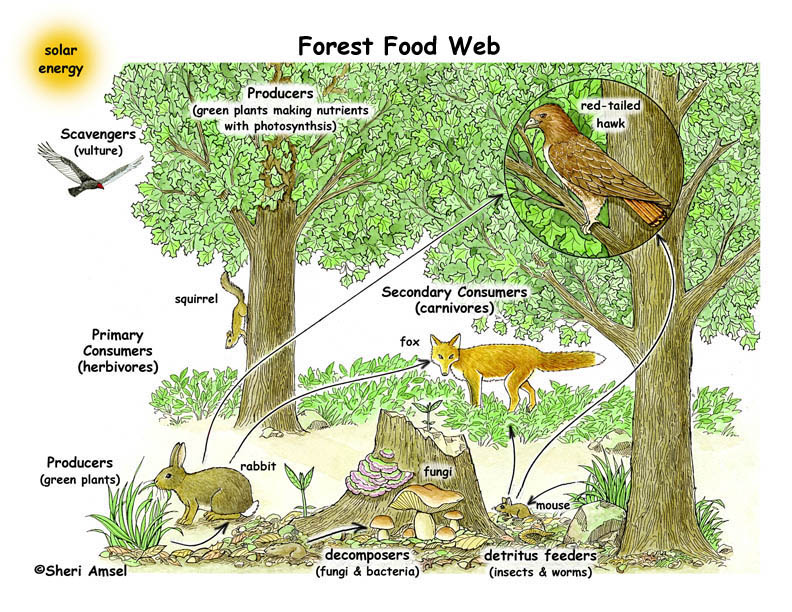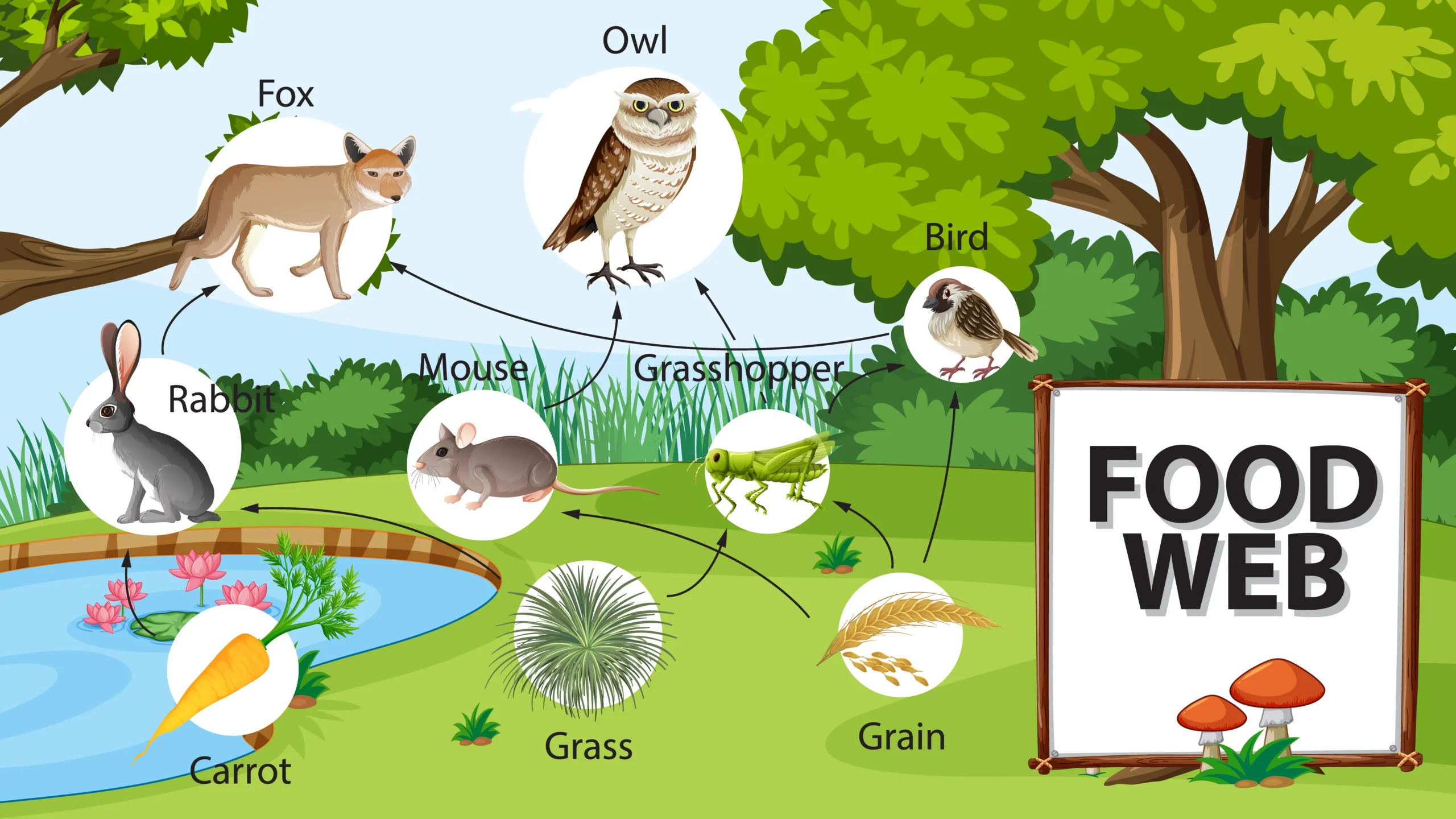Wooded area meals webs, intricate tapestries of lifestyles woven inside the verdant embody of nature, play a pivotal position in shaping the ecological stability of our planet’s verdant nation-states. Each and every organism, from the towering bushes that pierce the sky to the microscopic decomposers that toil underneath the woodland flooring, paperwork an indispensable hyperlink on this advanced internet of interdependence.
Inside those colourful ecosystems, a symphony of interactions unfolds, the place manufacturers, customers, and decomposers dance in a gentle stability. Number one manufacturers, similar to bushes and shrubs, harness the solar’s calories to create the basis of the meals internet, whilst herbivores, like deer and rabbits, graze upon this verdant bounty.
Evaluate of Wooded area Meals Webs
Within the intricate tapestry of a woodland ecosystem, the meals internet performs a pivotal position in keeping up ecological stability. A meals internet is a posh community of interconnected meals chains, representing the waft of calories and vitamins amongst other organisms inside a group.
Trophic Ranges
Inside a woodland meals internet, organisms are arranged into distinct trophic ranges in response to their feeding relationships. Number one manufacturers, similar to vegetation and algae, shape the basis of the internet through taking pictures daylight and changing it into energy-rich compounds thru photosynthesis.
Number one customers, usually herbivores, feed without delay on number one manufacturers. Secondary customers, similar to carnivores, prey on number one customers. This development continues up the trophic ranges, with each and every stage representing a better order of predation.
Examples of Wooded area Meals Webs
Wooded area meals webs range considerably throughout other biomes.
- Temperate Deciduous Forests:Those forests are characterised through a various array of plant species, together with oaks, maples, and birches. The meals internet contains herbivores similar to deer, squirrels, and rabbits, in addition to predators like wolves, foxes, and owls.
- Tropical Rainforests:With their abundance of daylight and moisture, tropical rainforests make stronger a extremely advanced meals internet. Number one manufacturers come with quite a lot of bushes, shrubs, and epiphytes. Herbivores come with monkeys, birds, and bugs, whilst predators come with jaguars, leopards, and snakes.
- Boreal Forests:Present in chilly, northern areas, boreal forests are ruled through coniferous bushes similar to spruce and fir. The meals internet is more practical in comparison to different woodland sorts, with herbivores similar to moose and caribou, and predators similar to bears and lynx.
Manufacturers and Number one Customers

Forests are intricate ecosystems teeming with lifestyles, the place organisms have interaction thru a posh meals internet. The basis of this internet lies within the manufacturers and number one customers.Manufacturers, similar to bushes, shrubs, and understory crops, harness daylight thru photosynthesis to create their very own meals.
Those vegetation give you the calories that sustains all the woodland ecosystem. Number one customers, basically herbivores, feed without delay on those manufacturers, shifting calories up the meals chain.
Herbivores: Adapting to Numerous Wooded area Habitats
Herbivores, similar to deer, rabbits, and squirrels, play a the most important position in woodland ecosystems. They devour plant subject matter, regulating plant enlargement and variety. Their grazing conduct can affect the construction and composition of plant communities, shaping the total woodland panorama.Other
herbivores have advanced diversifications to thrive in particular woodland habitats. For example, deer possess huge our bodies and lengthy legs, enabling them to navigate dense undergrowth. Rabbits, then again, have shorter legs and a compact frame, permitting them to dart thru dense crops and search refuge in burrows.
Squirrels, with their nimble claws and talent to climb bushes, exploit the vertical size of the woodland surroundings.
Secondary and Tertiary Customers

Secondary customers are organisms that feed on number one customers. They come with insectivores, small carnivores, and omnivores. Insectivores, similar to birds and bats, feed totally on bugs. Small carnivores, similar to foxes and coyotes, feed on small mammals, birds, and reptiles.
Omnivores, similar to bears and raccoons, feed on each vegetation and animals.Tertiary customers are organisms that feed on secondary customers. They come with huge predators, similar to wolves, bears, and lions. Tertiary customers play crucial position in regulating populations of secondary customers.
Through preying on secondary customers, tertiary customers assist to stay their populations in test. This will have a good impact at the ecosystem, as it may well assist to forestall overpopulation of secondary customers and the following depletion of sources.The idea that of trophic cascades describes the results of predators at the populations in their prey and the vegetation that their prey consume.
Trophic cascades will have a vital affect on woodland ecosystems. As an example, the elimination of wolves from Yellowstone Nationwide Park resulted in an build up within the inhabitants of elk. This, in flip, resulted in an build up within the surfing of aspen bushes through elk.
The aid in aspen bushes had a destructive affect at the inhabitants of beavers, which depend on aspen bushes for meals and refuge.
Decomposers and Nutrient Biking
Decomposers play an important position in woodland ecosystems, making sure the continual biking of vitamins again into the soil. They ruin down useless plant and animal topic, freeing crucial vitamins which can be then to be had for uptake through vegetation.
Sorts of Decomposers, Wooded area meals internet
Wooded area ecosystems are house to a various array of decomposers, together with:
- Fungi:Fungi are crucial decomposers, breaking down advanced natural topic into more practical paperwork. Mycorrhizal fungi shape symbiotic relationships with plant roots, facilitating nutrient uptake.
- Micro organism:Micro organism also are the most important decomposers, particularly in heat, wet environments. They specialise in breaking down natural topic into inorganic vitamins.
- Invertebrates:Invertebrates similar to earthworms, bugs, and snails devour useless plant and animal topic, additional breaking it down and aerating the soil.
Technique of Decomposition
Decomposition is a posh procedure involving the breakdown of natural topic into more practical components. It happens in levels:
- Leaching:Water-soluble vitamins are leached from useless plant and animal topic.
- Fragmentation:Invertebrates shred and ruin down natural topic into smaller items.
- Humification:Microorganisms, similar to fungi and micro organism, ruin down natural topic into humus, a dismal, nutrient-rich substance.
- Mineralization:Humus is additional damaged down through microorganisms, freeing inorganic vitamins into the soil.
Significance of Decomposers
Decomposers play a important position in keeping up woodland ecosystem well being:
- Nutrient biking:Decomposers recycle crucial vitamins, making them to be had for plant enlargement.
- Soil fertility:Decomposers produce humus, which improves soil construction and fertility.
- Ecosystem stability:Decomposers save you the buildup of useless natural topic, keeping up ecosystem stability.
Human Affects on Wooded area Meals Webs

Human actions can considerably affect woodland meals webs, changing the stability and balance of those ecosystems. Deforestation, habitat fragmentation, and air pollution are a number of the maximum prevalent threats.Deforestation, the clearing of forests for quite a lot of functions similar to agriculture, logging, and urbanization, without delay reduces the supply of habitat and sources for woodland species.
Habitat fragmentation, the breaking apart of enormous contiguous forests into smaller, remoted patches, additional isolates populations and bounds their get admission to to meals and associates.Air pollution, in particular air and water air pollution, will have each direct and oblique results on woodland meals webs.
Air air pollution can harm crops, lowering meals resources for herbivores and in the end affecting upper trophic ranges. Water air pollution can contaminate water resources, harming aquatic organisms and doubtlessly coming into the meals chain thru bioaccumulation.
FAQ Nook
What’s a woodland meals internet?
A woodland meals internet is a posh community of interconnected meals chains inside a woodland ecosystem, the place organisms rely on each and every different for sustenance.
What are the other trophic ranges in a woodland meals internet?
Trophic ranges come with manufacturers (vegetation), number one customers (herbivores), secondary customers (carnivores), and tertiary customers (most sensible predators).
How do decomposers give a contribution to the woodland meals internet?
Decomposers, similar to fungi and micro organism, ruin down useless organisms and recycle vitamins again into the soil, supporting the expansion of vegetation.
